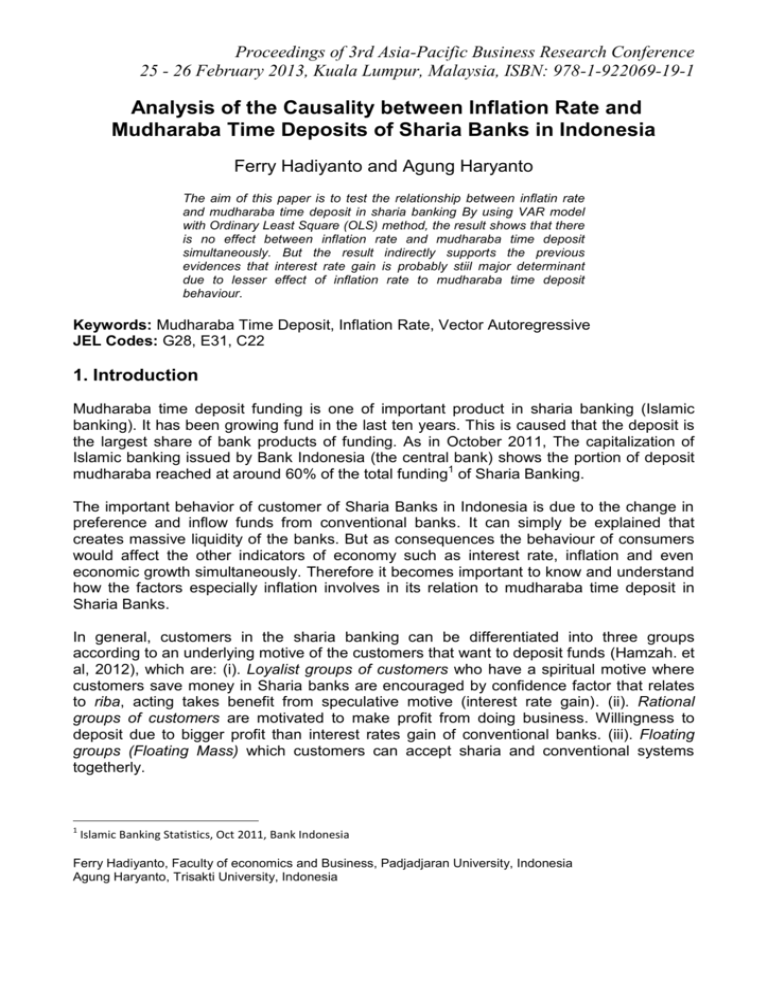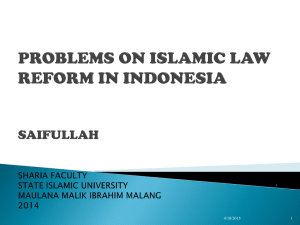To - WBI Conference Proceedings.
advertisement

Proceedings of 3rd Asia-Pacific Business Research Conference 25 - 26 February 2013, Kuala Lumpur, Malaysia, ISBN: 978-1-922069-19-1 Analysis of the Causality between Inflation Rate and Mudharaba Time Deposits of Sharia Banks in Indonesia Ferry Hadiyanto and Agung Haryanto The aim of this paper is to test the relationship between inflatin rate and mudharaba time deposit in sharia banking By using VAR model with Ordinary Least Square (OLS) method, the result shows that there is no effect between inflation rate and mudharaba time deposit simultaneously. But the result indirectly supports the previous evidences that interest rate gain is probably stiil major determinant due to lesser effect of inflation rate to mudharaba time deposit behaviour. Keywords: Mudharaba Time Deposit, Inflation Rate, Vector Autoregressive JEL Codes: G28, E31, C22 1. Introduction Mudharaba time deposit funding is one of important product in sharia banking (Islamic banking). It has been growing fund in the last ten years. This is caused that the deposit is the largest share of bank products of funding. As in October 2011, The capitalization of Islamic banking issued by Bank Indonesia (the central bank) shows the portion of deposit mudharaba reached at around 60% of the total funding1 of Sharia Banking. The important behavior of customer of Sharia Banks in Indonesia is due to the change in preference and inflow funds from conventional banks. It can simply be explained that creates massive liquidity of the banks. But as consequences the behaviour of consumers would affect the other indicators of economy such as interest rate, inflation and even economic growth simultaneously. Therefore it becomes important to know and understand how the factors especially inflation involves in its relation to mudharaba time deposit in Sharia Banks. In general, customers in the sharia banking can be differentiated into three groups according to an underlying motive of the customers that want to deposit funds (Hamzah. et al, 2012), which are: (i). Loyalist groups of customers who have a spiritual motive where customers save money in Sharia banks are encouraged by confidence factor that relates to riba, acting takes benefit from speculative motive (interest rate gain). (ii). Rational groups of customers are motivated to make profit from doing business. Willingness to deposit due to bigger profit than interest rates gain of conventional banks. (iii). Floating groups (Floating Mass) which customers can accept sharia and conventional systems togetherly. 1 Islamic Banking Statistics, Oct 2011, Bank Indonesia Ferry Hadiyanto, Faculty of economics and Business, Padjadjaran University, Indonesia Agung Haryanto, Trisakti University, Indonesia Proceedings of 3rd Asia-Pacific Business Research Conference 25 - 26 February 2013, Kuala Lumpur, Malaysia, ISBN: 978-1-922069-19-1 The related empirical evidences show there are the inter-flow of deposit between Islamic and conventional banks (Kasri and Kassim, 2009). Meanwhile, Abduh and Sukmana (2012) also prove that interest rate gain is still dominant for bank consumers so that antiriba campaign is not fully followed. The above evidences confirm that the existence of rational and floating costumers have important impact for sharia banks. Those are proven the behavior of sharia bank sensitive to financial gain and could affect conventional banks and the risk sharing of sharia banks, as well. The other effect of the behavior of sharia bank consumers is whether inflation causes the change of sharia banks deposit or not because of customer preferences. In Indonesia for the past of ten years, the behavior of inflation was more volatile than interest rate. That means in the changes of prices certainly would affect how people to allocate their wealth or asset to be more profitable. In turn, that might be believed to affect the size of mudharaba time deposit as well. This lead to be the phenomenon and hypothesis that is going to be tested in this paper. 2. Literature Review a. Inflation Rate Inflation is defined as the rate of change in price continuously (Mankiw, 2011). Meanwhile, Central Bank of Indonesia simply calculate inflation as a [ersistent, ongoing rise across a broad spectrum of prices. The measurement of inflation bases on the level of Consumer Pricwe Index (CPI). Changes in the CPI over time are indicative of price movements for packages of goods and services consumed by the public There are three commonly used price indexes to measure inflation are: (i). Consumer Price Index (CPI), the price index which measures a group of prices of goods / services in the household consumer level; (ii). Wholesale Price Index (WPI), the Wholesale Price of a commodity is the price of transactions that occur between the first seller / wholesaler with buyers / wholesalers in large quantities in the first market for the commodity; and (iii). Gross Domestic Product Deflator (GDP) describes the measurement of the level of final goods prices (final goods) and services produced within an economy (country). Generated by dividing the GDP deflator of GDP on the basis of nominal prices to GDP at constant prices2. According to the calculation theoretically will lead to the framework analysis that mechanism of intermediary function of sharia bank consider the change of inflation rate. The higher inflation rate represent the bigger incentive of doing business that will attract deposit mobilization. b. Mudharaba Mudharaba in Shar'iah, or Islamic law, refers to the payment of a specific amount of money to a person who uses it for business and makes a profit from it, or an investment. This form of a contract is permissible. Islamically, interest is forbidden. It is definitely forbidden to take interest when loaning other people money meaning they search for nointerest loans or alternate forms of payment often offered by Islamic bank. Therefore, this form of contract is much preferable. 2 Indonesia Statistics Office (BPS), Annual Report of Indonesia Statistics Book. Proceedings of 3rd Asia-Pacific Business Research Conference 25 - 26 February 2013, Kuala Lumpur, Malaysia, ISBN: 978-1-922069-19-1 Technically, al-mudharaba is a business cooperation contract between two parties in which the first party (Shahibul maal) provides the entire capital, while the other party becomes the manager. Doing business profits according to the Mudharaba agreement set in the contract, whereas the loss is charged to the owners of capital or shared between the two parties, as long as it is not due to negligence of the management (Antonio, 2009). Base on the Fatwa of The National Council of Sharia No. 03/DSN-MUI/IV/2000, dated 1 April 2000 on mudharabah deposit, provided the basis of sharia and the provisions of the deposit as follows: 1. In this transaction, the customer acts as Shahibul maal or owner of the funds, and Islamic banks as mudharib or fund manager. 2. In his capacity as mudharib, the bank can perform a variety of businesses that do not conflict with Islamic principles and develop them, including Mudharabah with others. 3. Capital should be stated with the amount, in cash and not receivable. 4. Profit sharing ratio should be expressed in the form set forth in the contract and account opening. 5. Banks as deposits mudharib cover operating costs by using a ratio advantage which they are entitled. 6. Banks are not allowed to reduce the ratio of profits. Finally, Mudharaba deposits are deposits of funds with mudharaba as owner of the funds in which costumers entrust their funds to be managed entirely by sharia banks, with appropriate sharing ratio agreed from the beginning. New mudharaba opening deposit must be base on a contract or agreement that in the name and address of the customer, and other attributes such as deposit amount, duration, ratio of profit sharing, profit sharing payment and principal at maturity and the terms of other mudharaba deposits. Sharia banks must have an agreement from the owner of the funds about the procedures for granting benefit, ratio and calculation of the profit distribution and risks that may arise from such sort of deposits. 3. The Methodology and Model The variables were employed in this paper basically refer to the hypothesis that show the causality between inflation rate and the value of mudharaba time deposits. The Two variables are assumed will show and prove how the their relations are going to exist. Therefore, Vector Autoregressive Regression (VAR) model is considered to be an estimation model to test the hypothesis. The variable of inflation is calculated for quarterly period, this means the inflation contains the summation of three months inflation. On the other side, mudharaba time deposits are taken from the Monthly Islamic Data Statistics that issued by Bank Indonesia. The VAR Model is made including all the variables described above. Consider the units used, deposit of mudharaba valued in billion rupiah. On the other side, inflation results in percentage term. VAR model has a difference approach from large scale econometric model. It focuses on the effect of the shocks or innovation (i.e, the residuals of estimated reduced form of unrestricted VAR) which modeled shocks as exogenous changes in the levels of policy variables, such as inflation. Proceedings of 3rd Asia-Pacific Business Research Conference 25 - 26 February 2013, Kuala Lumpur, Malaysia, ISBN: 978-1-922069-19-1 Let Z = (p,mudharaba)’, where p is the inflation rate and mudharaba is the value of mudharaba time deposits. Hence, the estimated equation is ∑ (1) And for the impulse respond function which is taken to examine pattern of response the vector of reduced form can be written as ∑ (2) Ordinary Least Square estimation techniques (OLS) is employed to test the causality between those two variables, even though it considers the each variable can be regressed separately and use econometrics software Eviews-6. Data processing is intended to produce the estimated value of the constant and coefficient of independent variables along with the test statistic according to the expected level of confidence. 4. The findings In aiming to analyse these two vector autoregressive model and constructed with one lag observation show that there is no inter causality between inflation and mudharaba time deposit. The models just prove that significantly effect is determined by its own variable. The historical behaviour of variable highly influences the current level for inflation and mudharaba time deposit as well. This findings, once again, support that the dominant factor that cause the change of mudharaba time deposit is probably interest rate or consumer income level. On the other side, the inflation change, as already expected, is to follow its time movement. People look at inflation change because of what happens in the past. The adaptive expectation is considered still exist. The result of VAR model can be seen as follows: Table. Regression Result of VAR model INFLASI LN_MUDHAR ABA INFLASI(-1) 0.758282 (0.10543) [ 7.19227] -0.015620 (0.01612) [-0.96915] LN_MUDHARABA(-1) 0.768674 (0.62433) [ 1.23120] 0.800084 (0.09544) [ 8.38308] C -21.05071 (18.2916) [-1.15084] 6.084647 (2.79622) [ 2.17603] R-squared Adj. R-squared F-statistic S.D. dependent 0.632421 0.612000 30.96908 3.692993 0.666058 0.647506 35.90162 0.592294 Source: data estimation Standard deviation in (.) and t-stat in [.] Proceedings of 3rd Asia-Pacific Business Research Conference 25 - 26 February 2013, Kuala Lumpur, Malaysia, ISBN: 978-1-922069-19-1 The extension of causality analysis between inflation and mudharaba time deposit is explored using impulse respond function (IRF). The generalized IRF captures the dynamic responses of dependent variables due to innovations in the variable itself. In the context of this study, the IRF analysis reveals the reaction of the mudharaba time deposit and inflation rate variables in the system. Accumulated Response of INFLASI to Cholesky One S.D. LN_MUDHARABA Innovation 10 8 6 4 2 0 -2 -4 1 2 3 4 5 6 7 8 9 10 Response of LN_MUDHARABA to Cholesky One S.D. INFLASI Innovation .20 .15 .10 .05 .00 -.05 -.10 -.15 -.20 1 2 3 4 5 6 7 8 9 10 Figure of Impulse Respond function of VAR model Source: data estimation Figure shows the generalized response of mudharaba time deposit to shocks of one standard deviation of inflation, vice versa. The first figure confirms that the response of inflation shows a persistent condition. A positive trends actually support that capitalization of sharia bank then convert it into the economy will expand business activities. That is believed to increase inflation rate due to higher aggregate demand. Meanwhile, the second figure indicates that the response of mudharaba time deposit follows the standard theory of money demand, when inflation increases will affect a decrease of value of saving or time deposit. People will prefer cash instead of put their assets at the banks. In other words, the customers of sharia banks, actually is “rational” depositors who are driven largely by the return that they get from time deposits saving instead of follows to be loyalist group and escape from conventional banks activities. The evidences also indirectly Proceedings of 3rd Asia-Pacific Business Research Conference 25 - 26 February 2013, Kuala Lumpur, Malaysia, ISBN: 978-1-922069-19-1 support how the customers are affected mostly by factors such as interest rate, income or money supply like already found by Kasri and Kassim (2009), Abduh and Sukmana (2012), Hamzah. et al (2012). 5. Summary The causality between inflation and mudharaba time deposits using VAR model confirms the previous evidences that there no significant relationship exist. Inflation rate tends to follow its historical bahaviour that shows adaptive expectation of customers decision. On the other side, mudharaba time deposits decrease is due to higher inflation put customers to prefer cash instead of put their assets at the banks. Finally, this paper indirectly support the previous evidences that found interest rate gain is still major effector in sharia banks financing due to lesser effect of inflation. References Abduh, Muhamad and Sukmana, Raditya, 2012, Deposit Behavior in Indonesia Islamic Banking: Do Crisis and Fatwa Matter?, On line at http://irep.iium.edu.my/24033/ Aggarwal, Rajesh K and Yousef, Tarik, 2000, Islamic Banks and Investment Financing; Journal of Money, Credit and Banking; Feb 2000. 32.1. pg.93 Antonio, Muhammad Syafi’i. (2009). Bank Syariah : Dari Teori ke Praktek. Jakarta: Gema Insani Press. p: 95. Aryanto, Yudho. (2010). Analisis Faktor-Faktor Yang Mempengaruhi Deposito Mudharabah Bank Syariah di Indonesia Tahun 2002.1 – 2009.12. Tesis. Fakultas Ekonomi Program Magister Perencanaan dan Kebijakan Publik Universitas Indonesia Jakarta. Bank Indonesia. Statistik Perbankan Indonesia. September 2011. On line at :http://www. bi.go.id/web/id/Statistik/Statistik+Perbankan/Statistik+Perbankan+Indonesia/ Hamzah, Muhammad Zilal et al, 2012, The Effect Analysis Between Inflation Rate, Deposit Interest Rate, and Profit Sharing Rate toward Mudharabah Time Deposit Rate, International Conference on: Competitiveness of the Economy in the Global Market University of Bung Hatta, Padang, West Sumatera, Indonesia. Karim, Adiwarman Z.(2011). Segmentasi Pasar Perbankan Syariah. Online at http:// permodalanbmt.com/bmtcenter/?p=816, Date : 10/10/2011. Kasri, Rahmatina A. and Salina Hj. Kassim.(2009). Empirical Determinants of Saving in The Islamic Banks: Evidence From Indonesia.J.KAU: Islamic Econ. Vol. 22 No. 2, pp: 3-23 (2009 A.D./ 1430 A.H.). Electronic copy available at: http://ssrn.com/abstract=1685226 Mohd Hussin, Mohd Yahya et al, 2012, Macroeconomics Variables and Malaysian Islamic Stock Market: A Time Series Analysis, Journal of Business Studies Quarterly, Vol 3, No.4, pp: 1-13 Proceedings of 3rd Asia-Pacific Business Research Conference 25 - 26 February 2013, Kuala Lumpur, Malaysia, ISBN: 978-1-922069-19-1 Appendix Vector Autoregression Estimates Date: 02/20/13 Time: 08:00 Sample (adjusted): 2003Q2 2012Q4 Included observations: 39 after adjustments Standard errors in ( ) & t-statistics in [ ] INFLASI LN_MUDHAR ABA INFLASI(-1) 0.758282 (0.10543) [ 7.19227] -0.015620 (0.01612) [-0.96915] LN_MUDHARABA(-1) 0.768674 (0.62433) [ 1.23120] 0.800084 (0.09544) [ 8.38308] C -21.05071 (18.2916) [-1.15084] 6.084647 (2.79622) [ 2.17603] 0.632421 0.612000 190.4983 2.300352 30.96908 -86.26720 4.577805 4.705771 7.278803 3.692993 0.666058 0.647506 4.451728 0.351652 35.90162 -13.01835 0.821454 0.949420 29.64285 0.592294 R-squared Adj. R-squared Sum sq. resids S.E. equation F-statistic Log likelihood Akaike AIC Schwarz SC Mean dependent S.D. dependent Determinant resid covariance (dof adj.) Determinant resid covariance Log likelihood Akaike information criterion Schwarz criterion 0.638643 0.544169 -98.81155 5.374951 5.630884 Date: 02/20/13 Time: 08:02 Sample (adjusted): 2003Q3 2012Q4 Included observations: 38 after adjustments Trend assumption: Linear deterministic trend Series: INFLASI LN_MUDHARABA Lags interval (in first differences): 1 to 1 Unrestricted Cointegration Rank Test (Trace) Hypothesized No. of CE(s) Eigenvalue Trace Statistic 0.05 Critical Value Prob.** None At most 1 * 0.179851 0.154304 13.90284 6.368620 15.49471 3.841466 0.0856 0.0116 Trace test indicates no cointegration at the 0.05 level * denotes rejection of the hypothesis at the 0.05 level **MacKinnon-Haug-Michelis (1999) p-values Proceedings of 3rd Asia-Pacific Business Research Conference 25 - 26 February 2013, Kuala Lumpur, Malaysia, ISBN: 978-1-922069-19-1 Unrestricted Cointegration Rank Test (Maximum Eigenvalue) Hypothesized No. of CE(s) Eigenvalue Max-Eigen Statistic 0.05 Critical Value Prob.** None At most 1 * 0.179851 0.154304 7.534220 6.368620 14.26460 3.841466 0.4280 0.0116 Max-eigenvalue test indicates no cointegration at the 0.05 level * denotes rejection of the hypothesis at the 0.05 level **MacKinnon-Haug-Michelis (1999) p-values Unrestricted Cointegrating Coefficients (normalized by b'*S11*b=I): INFLASI -0.228500 0.208974 LN_MUDHARA BA -0.817607 -1.699032 Unrestricted Adjustment Coefficients (alpha): D(INFLASI) D(LN_MUDHA RABA) 0.636653 -0.715535 0.136476 0.073879 1 Cointegrating Equation(s): Log likelihood -98.71647 Normalized cointegrating coefficients (standard error in parentheses) LN_MUDHARA INFLASI BA 1.000000 3.578145 (2.89384) Adjustment coefficients (standard error in parentheses) D(INFLASI) -0.145475 (0.08907) D(LN_MUDHA RABA) -0.031185 (0.01359)







